Game Flow Analysis Tool
Thanks to the newly-developed Game Flow Analysis Tool you can make sure your game is actually fun to play by analyzing video recordings of the game play. Right after the recording players get to see the video showing them playing the game. Now it's their task to answer four questions every minute. Taking Mihaly Csikszentmihalyi's well-known flow model a step further, we now use the answers to find out more about players' emotional states while playing the game.
The final result is a complete analysis of all emotional conditions experienced during the game. Based on players' emotions, several deductions can be made.
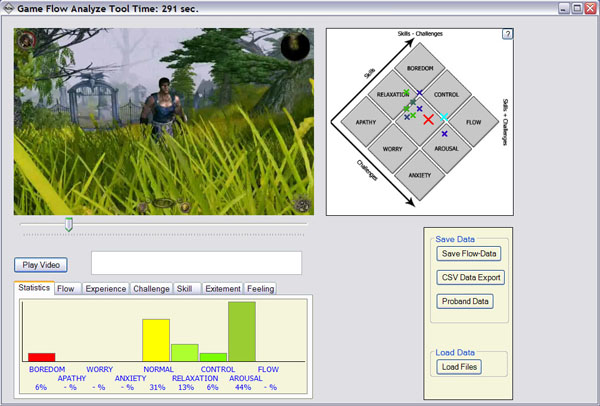
Analysis Results
Game Play Fun Rating
y capturing players' emotional states, you can determine whether they felt rather positively or negatively while playing the game. The results of the statistical analysis are presented in the 8 channel flow model. In the case shown above the player mainly felt positively during the game - he enjoyed the experience.
Information like that can come in handy for game developers when negotiating with publishers. And with the Game Flow Analysis Tool publishers for the first time have a tool at their fingertips, which helps them testing a game on their target audience and getting a reliable and developer-independent estimate on the product's chances in the market.
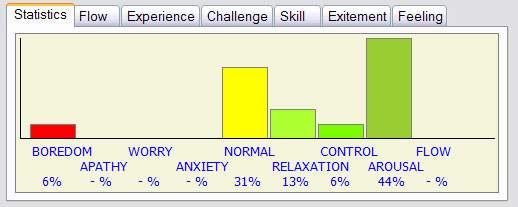
Weakness Analysis
The example shown here is particularly interesting for the developer of the game, because it shows a BOREDOM rate of 6%. Now the question is, what sort of event in the game led to such a result. Since the in-game action was captured on video, you can now get right to that moment with a mouse click using the Flow View and have look at a minute of game play. That way developers get access to detailed information on what exactly players did, which in turn will help them isolating those elements of the game that still need to be improved.
The Flow View shows that the BOREDOM area was barely touched at all, so, in this case, there is no need for alarm. The red cross marks the average of all measurements while the small blue cross stands for the current position in the game play experience. The other crosses visualize single ratings from green (beginning) to blue (end).
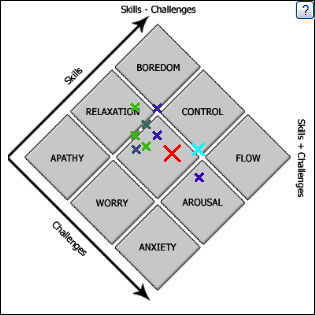
Balancing
Apart from a game's fun factor, you can also analyze how difficult players thought the game was. That way developers can isolate and hopefully solve problems. After all, bad balancing is not always the reason why players can't get past a certain point in the game. Possible causes include wrong mission texts, missing GUI information or buggy mission design. Both flow and experience displays will help you find and solve those problems.
Flow-Analyse
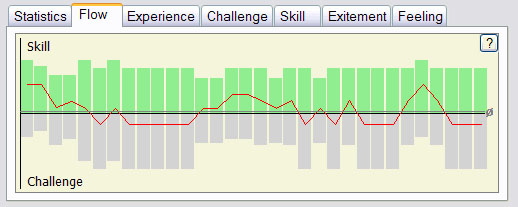
The flow display shown here stands for the classical approach of measuring flow by comparing skill and challenge. If both factors are rated equally, the player is in the flow. If the game is too easy, the red line will stay above the black zero line. But if the challenge is too big, the red line will stay beneath the zero line. Ideally, the red line moves up and down - the player adapts to the game's challenges and overcomes more and more difficult problems.
Emotion Analysis
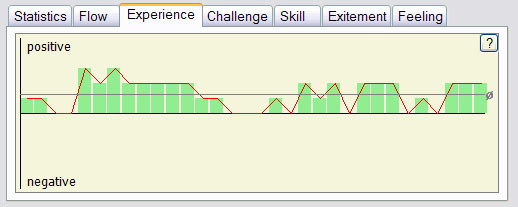
By expanding the classical flow model, the player's emotions can also be displayed during the game. That way, it is easy to see how players react to challenges. The example here makes it obvious that the test person responded positively to challenges becoming more and more difficult. The best emotion ratings coincide with increasing challenges.
Test Environment Limits
Several things need to be kept in mind to get viable results and readings.
Maximum playing time: 60 minutes
Since the questionnaires will have to be based on players' recollections right after the end of the gaming session, it is crucial to keep the session period as short as possible, so players can still remember a large number of details. That is why a total playing time of 60 minutes is recommended. Since the measurements themselves take up 1.25 to 1.5 times the playing time, shorter playing sessions would be even better. There are two possible ways to do this: Players get access to a certain limited area only or they have to solve a given task as quickly as possible.
Undisturbed test situation
The quality of the data mainly depends on whether players get distracted while playing. Ideally, arrangements should be made for a separate room with just a single test person. Distractions such as mobile phones etc. should be eliminated as much as possible.
Video capture
Video capture, especially in high resolutions, is often a problem. In its current version, the Game Flow Analysis Tool can only analyse a single video file. If the video has to be split up into several files (2 GB limit), only the first video file can be analyzed, not the entire sequence.
There are three work arounds for that problem:
- Reducing the resolution (halving the resolution during recording)
- Reducing the frame rate (5 fps will be more than enough)
- Using a codec with a higher compression rate (not supported by every software)

